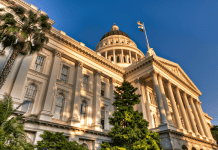 A tax system that allows employers to plan for the future is a key to a solid business environment, the California Chamber of Commerce explained to an Assembly committee this week.
A tax system that allows employers to plan for the future is a key to a solid business environment, the California Chamber of Commerce explained to an Assembly committee this week.
The Assembly Revenue and Taxation Committee’s February 22 informational hearing was dedicated to examining the state’s “tax expenditure” programs, so-named because policymakers see tax credits as reducing income that otherwise would come into the state’s coffers.
“Tax expenditures allow California businesses to have some certainty when planning for the future,” CalChamber Policy Advocate Preston Young told the committee.
He summarized tax factors that make California a difficult place in which to do business:
- California has the highest state sales and use tax rate in the country (7.25%) and local governments are permitted to levy additional taxes on top of the state rate.
- California has both the highest gas tax rate and the highest personal income tax rate in the country.
- California’s corporate tax rate of 8.84% is the highest in the Western United States and seventh highest in the country.
Although the state’s employers have shown they can deal with a difficult business environment, an “unpredictable environment … doesn’t allow for planning, hiring, expansion or success,” Young said.
Tax Remedies
Young cited the manufacturers investment tax credit and the research and development (R&D) credit as examples of how the state’s tax structure discourages particular activities, but the tax expenditure provides a remedy and encourages business and employment growth.
In both cases, the tax expenditures were considered, debated and worked on directly by the Legislature, he noted.
- Sales and use tax exemption for manufacturing: Before the exemption, manufacturers were taxed twice: once for the equipment they bought to produce a product and again when they were selling that product. As a result, products were produced outside the state to avoid the double tax.
- R&D credit: R&D activity in California is robust, thanks in large part due to the R&D tax credits. California companies generated more than $144.5 billion in R&D activity in 2018 — nearly five times the amount of the second-ranked state. The R&D benefits apply not just to equipment like lasers or scales, Young pointed out, but also the wages paid to workers engaged directly in research or directly supervising or supporting the researchers. Jobs in the R&D sector have some of the highest wages in California.
Fiscal Impact
Federal and state statistics show that tax expenditures specific to business make up a small portion of the fiscal impact on the state, Young said.
From a federal perspective, 90% of tax expenditures are due to the personal income tax and just 10% to business.
The state Department of Finance reports that for the 2022–23 tax year, General Fund revenues were reduced $65.5 billion due to the personal income tax, $8.7 billion by the business corporate tax and $12.8 billion from the sales and use tax exemption.
In closing, Young commented that tax expenditures can encourage businesses to engage in an activity that they otherwise wouldn’t and allow the state’s economy to grow while allowing businesses here to provide good-paying jobs to Californians.
For best results, he said in response to questions from committee members, tax expenditure policy for employers “should facilitate an atmosphere where you can plan.”
Staff Contact: Preston Young


